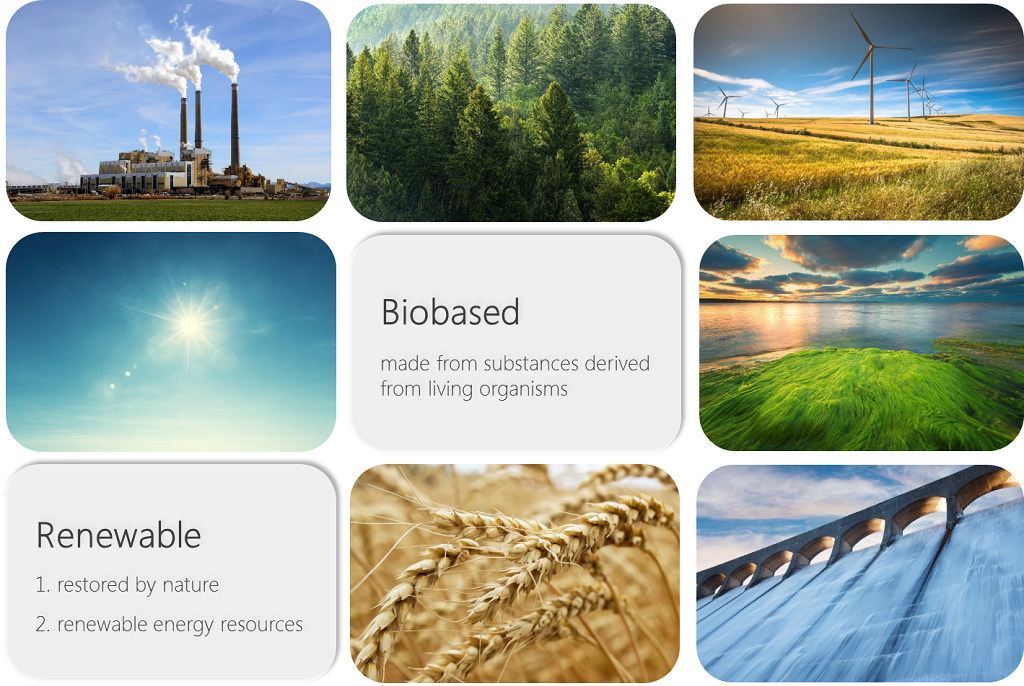Bio-based and renewable
According to Cradle-to-Cradle, all materials can, through the right design, become nourishment for either microorganisms or industrial processes. By doing this waste is eliminated as a concept – earlier waste becomes either nourishment for the earth or valuable new raw materials for industry. In this way, the cradle-to-cradle approach supports the new circular economy.

One way of slowing down climate change is to switch from fossil to sustainable, bio-based and renewable resources or maybe even better to recycled materials, which already exists in our systems today. Bio-based raw materials are derived from living organisms such as different types of crops, wood, and algae. Renewable is a word used for both raw materials and energy. All bio-based raw materials are also renewable, but renewable sources can be a number of things, such as the sun, wind and water.
Storing CO2
But why is it better to use bio-based and renewable sources than the fossil ones? All living organisms, like the ones mentioned above, use photosynthesis to grow and develop. Photosynthesis is a process where the organism uses CO2 from the air to build up its constituent biomass. By doing so, CO2 is taken from the atmosphere and “stored” in the organisms. When the organism, like a tree, is then later used as a raw material, and at the end of life burned or degraded, this “stored” carbon is released as CO2 in the atmosphere. This means there is less net addition of CO2 to the atmosphere, when a bio-based material is used compared to a fossil one. Of course, there can be CO2-emissions connected to other steps in the cultivation, production, and transport of the biomass. When shifting away from fossil raw materials, it is crucial that this is made sustainably, in every step.

Cradle to...
Carbon footprint is the amount of greenhouse gases like CO2 that are emitted into the atmosphere connected to e.g. a particular product, or activity. The carbon footprint is expressed in CO2 equivalents and equals the CO2 added to global warming. The carbon footprint for a product is calculated as either cradle-to-gate or cradle-to-grave. Cradle-to-gate includes all the CO2 emitted during the production of the product up to the production gate of a company or organization. It comprises steam, electricity, and transports from the extraction of the raw materials and includes all the different steps up to the gate. Cradle-to-grave also adds the phase of usage and the end-of-life. At the end-of-life it is normally assumed that all carbon in the product is turned into CO2, either by combustion or degradation. If the carbon is fossil-based, it adds to the carbon footprint and if it is renewable it does not.Beyond take, make and dispose
Looking beyond the current “take, make and dispose” model of consumption, which relies on large quantities of resources, the model of a circular economy takes us towards a sustainable way of living, reducing waste and minimizing negative impacts. In the circular economy the end of life of a product is the beginning of something else.
Cradle-to-cradle design is an approach that uses nature’s own processes as a model for human production that is based on the three following principles:
• Waste = Nourishment
• The sun as energy source
• Encourage diversity
According to Cradle-to-cradle, all materials can, through the right design, become nourishment for either microorganisms or industrial processes. By doing this waste is eliminated as a concept – waste becomes either nourishment for the earth or valuable new raw materials for industry. In this way, the cradle-to-cradle approach supports the new circular economy.
